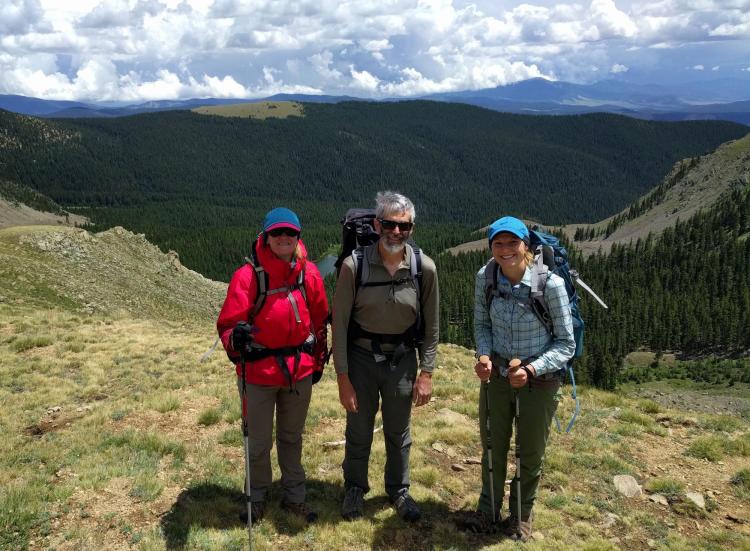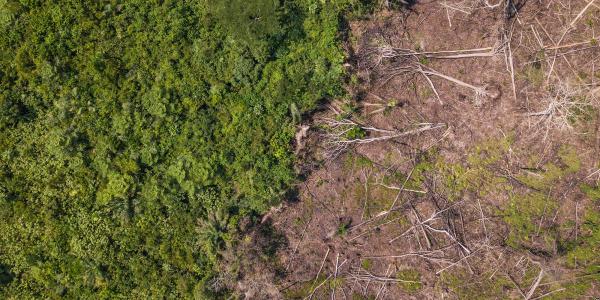‘It’s not really on the radar for incoming students and parents, but there is that opportunity, and it can make a big difference for our students,’ says Professor Daniel Doak
Professor Daniel Doak wasn’t surprised when the research of his recent undergraduate student Rachel Irons was published in the journal Proceedings of the Royal Society B, last spring. After all, the University of Colorado Boulder environmental studies professor had been mentoring her for some time.
Undergraduate research can help students gain skills and launch careers, but many students matriculate without knowing about the option. Doak, who holds CU Boulder’s Colorado Chair of Environmental Studies, emphasizes the value of undergraduate research both for the students and for the university.

April Goebl, a PhD student in ecology and evolutionary biology, Daniel Doak, professor of environmental studies, and Megan Peterson, a post-doctoral researcher in Doak's lab, take a moment on Niwot Ridge at the Mountain Research Station. At top of the page, Peterson joins students Eliza Hall and Grace Kendziorski on the ridge. Photos courtesy of Daniel Doak.
“There are some undergraduate students who absolutely are at the same level as our graduate students,” said Doak, who has led a half-dozen undergraduate students along the road to publishing. “And I think that’s a really neat thing about working here at CU. It’s not really on the radar for incoming students and parents, but there is that opportunity, and it can make a big difference for our students.”
Doak said he currently has about five undergraduate students — working directly or in association with him — who will probably be able to publish their current research in peer-reviewed scholarly journals.
CU environmental studies majors Ellen Waddle and Grace Kendziorski are working on Doak’s moss campion study on Niwot Ridge at CU’s Mountain Research Center, funded by CU’s Research Experiences for Undergraduates program, along with Elijah Hall, from Juniata College in Pennsylvania, and Lucas Piedrahita, from Appalachian State University in North Carolina.
Also, Emily Valencia is a senior thesis student who worked in Kenya with Doak’s PhD student, Allison Louthan. Valencia is studying how the loss of large mammals, and subsequent change in plant habitats, can affect pollinators.
“A great thing about CU is the availability of grants that can help undergraduates do excellent work and eventually publish,” Doak said. “You can’t put in the time for hundreds, or even dozens, of students at a time, but there will be quite a few who are inquisitive and dedicated enough to pursue their research that far.”
Publishing their research is obviously beneficial to students anticipating graduate school, but Doak said the advantages go beyond the obvious.
Publishing teaches a great deal about writing and communication that transfer to many fields, and it is tangible evidence of their skills and work ethic that are important contributions to their resumes.”
“It is a lesson in the process of how science tries to sort out truth from conjecture and how the work they did can contribute to this process,” he said. “Publishing teaches a great deal about writing and communication that transfer to many fields, and it is tangible evidence of their skills and work ethic that are important contributions to their resumes.”
The dedication to publish is often the biggest challenge for undergraduates, Doak said. For instance, Irons worked on the published version of her senior thesis for two years after graduating, three years after she finished her fieldwork in Alaska.
“I think I knew from very early on that she would publish,” Doak said about the article, for which he was a co-author. The research showed nesting swallows in sub-arctic areas were more prone to lay their eggs according to changing precipitation or wind, rather than just rising temperatures.
“She had conceived this idea of what she wanted to do, and was already working with people in Alaska (Department of) Fish and Game,” Doak said. “But I knew of some interesting work being done by Alex Rose (a researcher in CU’s Science Discovery and Institute of Arctic and Alpine Research), and together we conceived that she (Irons) could do an interesting set of new analyses — a complete and compelling analysis.”
That scenario is typical of undergraduates publishing their work, Doak said. While they are often extremely enthusiastic about their studies, they often don’t see where that research might fall into other sets of inquiry. And they’ll probably need some help in statistics and writing, as well, Doak added.
“I didn’t do any field work in Rachel’s study. I was there to help her work through the statistics and writing,” Doak said. The professor has been working on a 17-year climate change study of moss campion and alpine bistort, which encompasses alpine and arctic environs from New Mexico to Alaska.
“Because I am in the field so much, a lot of working with students really falls on my post-doc, Megan Peterson,” Doak said. “She’s been critical to the success of some of these undergraduate students — she’s really enthusiastic and communicates extremely well with the students.”
But the experience has been quite rewarding for Doak, as well, extending his interaction with recent graduates well past the time they left the university.
“She (Irons) has done some really diverse things after finishing at CU — she’s into worked on organic farms, hiked the Pacific Crest Trail. You get to see these adventurous days of their lives,” Doak said.
“It’s fun to see creative and motivated people like Rachel doing things that are well beyond the one aspect of their lives I’m usually associated with.”



